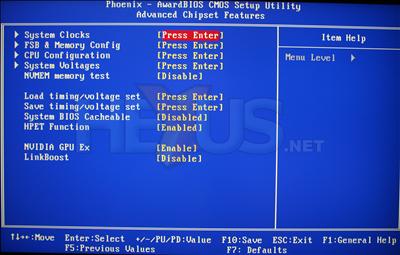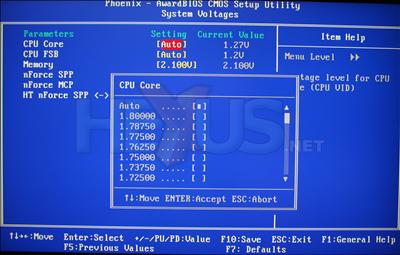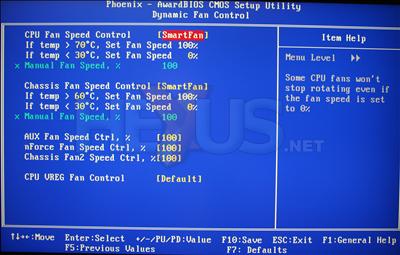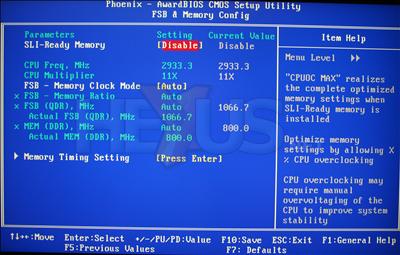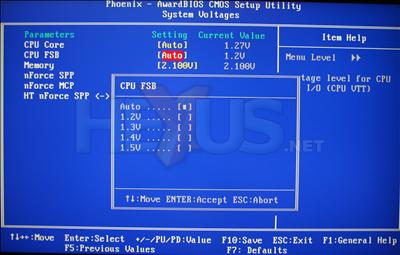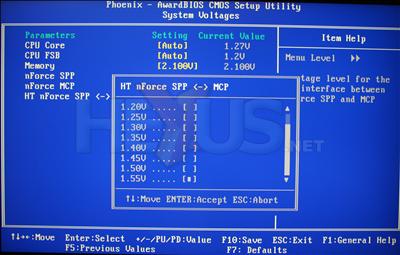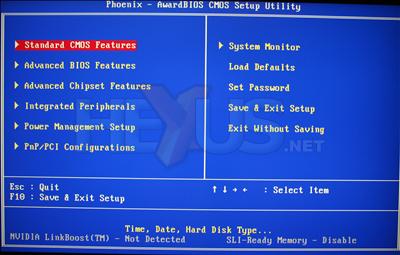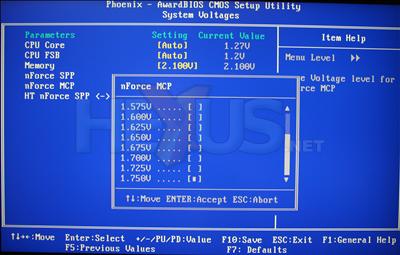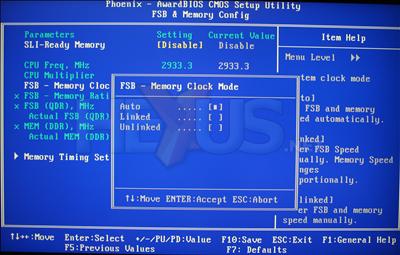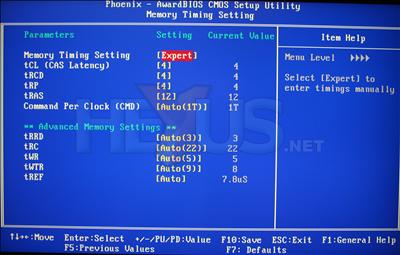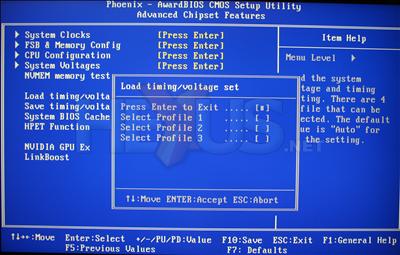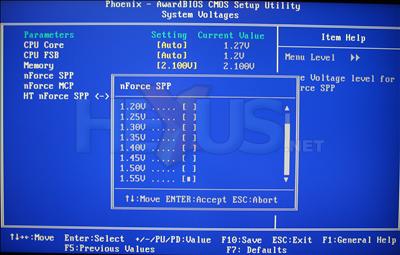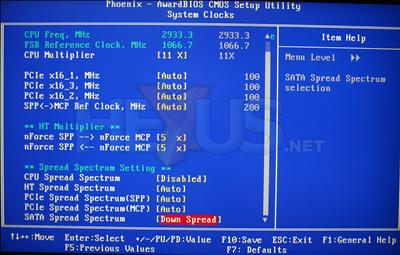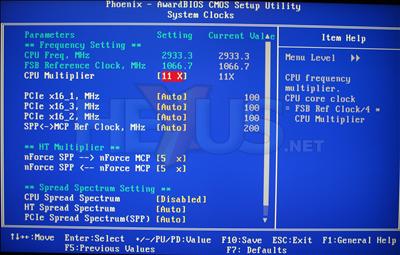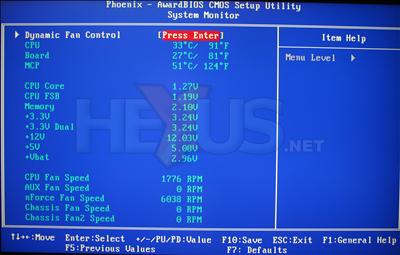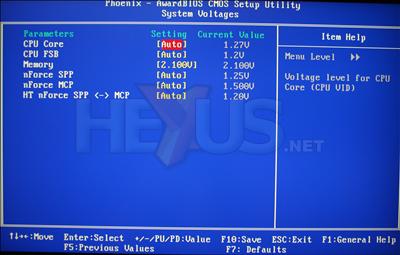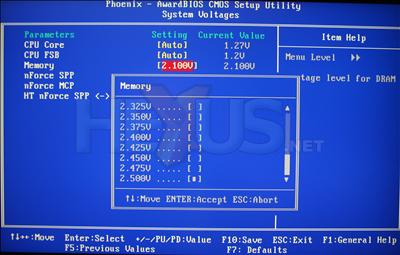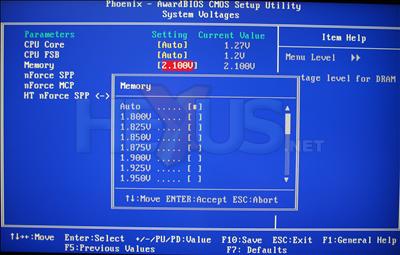BIOS and Overclocking
The BIOS for the eVGA nForce 680i SLI is tremendous; the engineers for it providing good English descriptions of most settings in the side panel (something usually glossed over on most boards) while laying out the BIOS logically with adjustment functions grouped together by their type. Want to adjust a voltage? All voltage adjust is in one place. Want to adjust a clock? Same there. Memory timings and everything else are all grouped as you'd want, too. Here are the ranges of adjustment before we have a closer look in pictures.| Item | Adjustment |
|---|---|
| CPU bus frequency | 100 to 625MHz in 0.25MHz steps |
| DRAM frequency/multis | DDR2 400 to 1400MHz in 1MHz steps, unlinked, EPP |
| CPU voltage | Up to 1.80000V in 0.0125V steps |
| DRAM voltage | 1.800V to 2.500V in 0.025V steps |
| PCI Express frequency | 100 to 200MHz in 1MHz steps, individual control over each x16 slot |
| 680i SPP voltage | 1.20V to 1.55V in 0.05V steps |
| FSB voltage | 1.2V to 1.5V in 0.1V steps |
| 680i MCP voltage | 1.50V to 1.75V in 0.05V steps |
| CPU boot FID adjust | Yes; depends on CPU |
| CPU boot VID adjust | Yes; depends on CPU |
| Intel Speedstep Control/EIST | Yes |
Discussion
The adjustment ranges are mighty, but it's how they're presented and are able to be adjusted that's the big winner for these boards. The new 680i SPP is able to unlink CPU bus and memory bus and run each asynchronously, letting you set just what you want in terms of each clock. There's little worrying about dividers to be done and the BIOS shows you old and new clocks as you change settings just so you're clear on the consequence of making an adjustment. Heavy-duty overclocking made quite easy, we reckon, and a real selling point of the board.The hardware monitoring section updates close to real-time and seems accurate, and the fan control section give you decent control over the majority of the fan headers from CPU to AUX and Vreg in between. Some of the fan controls are binary, but the majority have granular control to let you control the thermal and noise profile of a PC built around the board, if the board is allowed to control the fans connected. Finally before we let you see the BIOS in pictures (the best way to judge it we reckon), there's profile support for storing three preferential sets of settings, and a recovery system that'll automatically kick the board back to life with last known good settings, should something you poke cause it to stop working.
It all adds up to making tweaking your system a piece of proverbial cake. Useful for cack-handed idiots like me that don't know their QDR from their multiplier from their SPP voltage ;) The best mainboard BIOS ever? abit might have some words to say about that, but it's certainly very close in your reviewer's opinion, if not the best and most usable.
Image Gallery
Overclocking
Overclocking-wise, NVIDIA make a big deal that CPU bus clocks can be raised to at least 500MHz out of the box with Core 2 Duo on this board. 500MHz is almost a mythical number in overclocking circles, with many boards struggling to get near, or falling just short. So being able to hit 500MHz easily without board mods and with unlinked memory frequencies is a big deal. A Really Big Deal™, etc.So we did nothing other than set 2000MHz bus frequency (the BIOS deals in the effective frequency) and 6x on our Core 2 Duo, and rebooted. No voltage adjust for anything, or change of settings, or otherwise.

It worked, as you can see, and that setting was rock stable for every piece of testing we threw at it. The extra 66MHz is no issue for the CPU at default voltage, but that's besides the point since voltage adjustments are as easy as adjusting anything else, so getting the most out of your hardware when tweaking is the board's arguable pièce de résistance. We managed just shy of 550MHz in the end, and as always your results will vary depending on your sample and your hardware.






